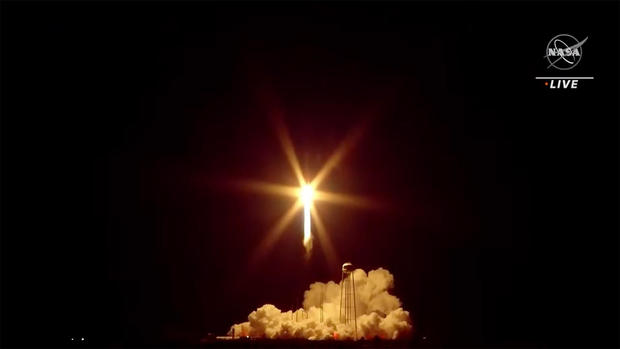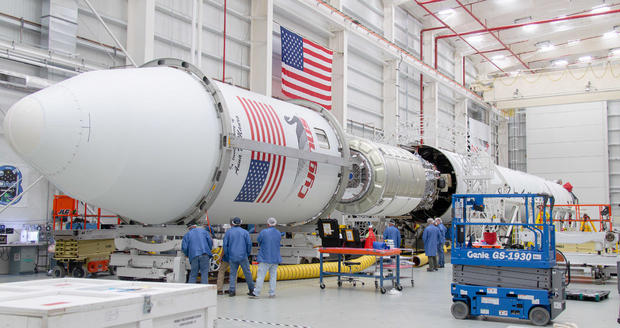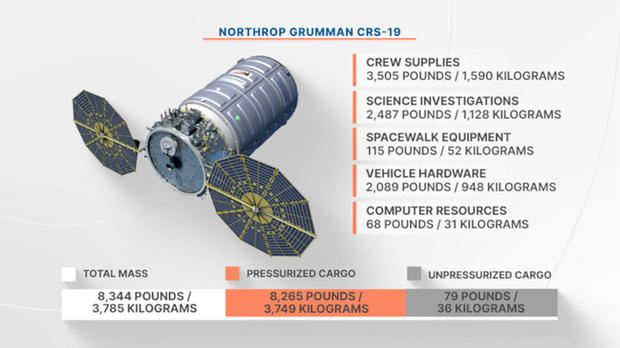End of an era for Northrop Grumman's Antares rocket with Russian and Ukraine components
Northrop Grumman launched its final Antares 230+ rocket Tuesday on a flight to deliver 4 tons of supplies and equipment to the International Space Station, the swan song for a booster built as a commercial venture with U.S., Russian and Ukrainian components.
Liftoff from the Mid-Atlantic Regional Spaceport — MARS — at NASA's Wallops Island, Virginia, flight facility came on time at 8:31 p.m. EDT, roughly the moment Earth's rotation carries pad 0A, on Virginia's Eastern Shore, into the plane of the space station's orbit.
The Antares first stage, powered by two Russian-built RD-181 engines with propellant tanks and plumbing provided by Ukraine, boosted the Antares out of the lower atmosphere and then fell away, handing off to a Northrop Grumman-built second stage carrying the Cygnus capsule.
Six minutes and 50 seconds after liftoff, the second stage motor burned out and the cargo ship was released to fly on its own in an initially elliptical orbit with a low point of 110 miles and a high point of 188 miles.
If all goes well, Northrop Grumman's unpiloted Cygnus spacecraft will catch up with its quarry early Friday, pulling up to within about 30 feet of the lab complex to await capture by the station's robot arm. From there, it will be pulled in for berthing at the Earth-facing port of the central Unity module.
"This vehicle will deliver over 8,000 pounds of cargo," said station program manager Joel Montalbano. The total includes "just over 2,400 pounds of utilization and research hardware, over 2,000 pounds of systems hardware and over 3,500 pounds of crew support equipment that we'll use for spacewalks as well as food and other consumables for the crew."
Included with the crew supplies: fresh grapefruit, apples, oranges, cherry tomatoes and blueberries, along with a pizza kit, an assortment of cheeses and ice cream.
As Montalbano quipped: "A well-fed crew is a happy crew."
Northrop Grumman's 19th station resupply flight — NG-19 — is the last using an Antares 230+ rocket, primarily because of supply chain issues amid the ongoing war between Russia and Ukraine. The next three Cygnus flights will use SpaceX Falcon 9 rockets while Northrop Grumman and Firefly Aerospace develop a new rocket — the Antares 330 — using American-made components.
In the meantime, despite the ongoing conflict, Kurt Eberly, Northrop Grumman's director of space launch programs, said engineers in both countries were still working with their American counterparts to ensure a safe flight for NG-19.
"We've had a number of (Ukrainian) personnel here on site at Wallops, and they've provided their usual support over the past year and are in their usual roles here for NG-19.
"They don't actually operate any of the hardware. Northrop Grumman employees control the rocket, but it's really great to have our Ukrainian partners here advising us and providing (their) design expertise."
As for the Russian RD-181 engines, Eberly said Russian engineers remotely participated in the most recent previous Cygnus launch and were expected to provide that same virtual support for NG-19.
"We appreciate that they are supportive of the International Space Station program and that they see the benefit to providing that support and getting these missions launched for the benefit of the entire ISS partnership," Eberly said.
As with all resupply fights, a major objective is to deliver science gear to the station for ongoing research.
Heidi Parris, associate space station program scientist, said experiments in a wide variety of disciplines are packed aboard the Cygnus, ranging from materials science and biomedical research to technology development for future missions to the moon and Mars.
She said the space station "enables scientists from around the world to really redefine the boundaries of their discipline by imagining what might be possible if you could take gravity out of the equation."
The Cygnus launch kicks off a busy two months for the space station program.
On Aug. 9, cosmonauts Sergey Prokopyev and Dmitri Petelin plan to stage their fifth spacewalk this year, followed by a Cygnus thruster firing two days later to boost the lab's altitude.
A Russian Progress cargo ship will undock and depart the station on Aug. 20. The next day, at 5:23 a.m. on Aug. 21, NASA plans to launch four fresh crew members to the lab aboard a SpaceX Crew Dragon capsule.
The Crew 7 astronauts — NASA's Jasmin Moghbeli, European Space Agency astronaut Andreas Mogensen, cosmonaut Konstantin Borisov and Japanese veteran Satoshi Furukawa — will replace four long-duration station fliers, Crew 6, who plan to return to Earth on Aug. 28 to wrap up a 179-day mission.
Before that, on Aug. 22, the Russians plan to launch another Progress cargo ship.
On Sept. 15, Russia will launch the Soyuz MS-24/70S spacecraft carrying cosmonauts Oleg Kononenko, Nikolai Chub and NASA's Loral O'Hara to the space station.
They will replace Prokopyev, Petelin and NASA astronaut Frank Rubio, who will close out a marathon 371-day mission with landing in Kazakhstan on Sept. 27. Launched on Sept. 21, 2022, they originally planned to come home in March, but their Soyuz suffered a massive coolant leak in December.
A replacement Soyuz was launched in February, but the crew's stay aboard the station was extended six months to put the Russian flight sequence back on its normal schedule.
As a result, Rubio will set a new U.S. single flight record, eclipsing astronaut Mark Vande Hei's current 355-day mark on Sept. 11.







